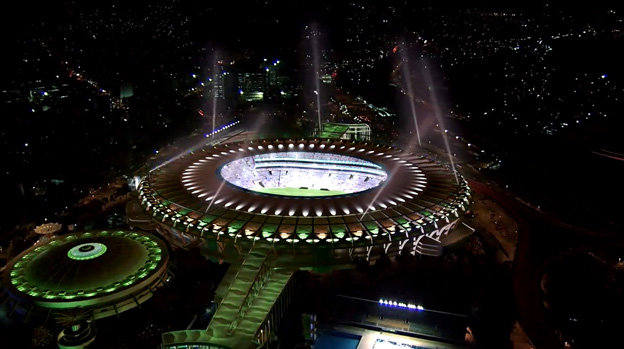With Germany taking home the World Cup 2014 trophy this year, Simon Greenwood, Commercial Director Europe at GE Lighting shares in this blog entrry some lighting techniques adopted for the stadiums.
2014 For one month this summer, the world's eyes turned to Brazil for the sporting event of the year. With many of the matches played at night time, the World Cup has thrown up some interesting lighting challenges – and in particular has highlighted how advancing technology has raised our lighting requirements and expectations.
Lighting night matches requires careful planning to ensure that both the players and the spectators in the stadium are able to see the action as clearly as if it were taking place in broad daylight. However, with millions of viewers tuning in across the globe, a bigger consideration is ensuring that the stadium is optimally lit for television cameras, providing maximum visibility with minimal glare. Considering the scale of the stadiums where the World Cup will take place, this is no mean feat.
 |
|
Brazil World Cup stadium lit up with GE lights. (LEDinside/GE) |
Most importantly however, given that the images will be shot and beamed around the world in high definition, the required lighting standards are substantially higher than that of previous World Cups. HD broadcasting requires 10 times greater illumination and color accuracy than conventional broadcast formats, which has a significant impact on the number and layout of the lights.
TV crews need bright, uniform light of at least 2,000 lux to broadcast picture-perfect digital images, free from shady areas, hard outlines and glare. Vertical lighting is essential, as it allows TV to capture details and close-ups of the players. It is also important that the lighting does not vary along the pitch because this can create either shady or excessively bright areas, diminishing the quality of the images.
Hard outlined shadows on the pitch are the main obstacles to broadcasting high-resolution digital videos and so repeating focus from different locations around the stadium is the best way to ensure players are lit from all angles, thus minimizing the amount of shadows they cast.
To achieve this, the height at which the light fixtures are mounted should be 25 degrees above the horizon looking from the center of the pitch towards the grandstand for lateral spotlight supports and posts, and should not exceed 45 degrees in the case of spotlight supports and the lighting structure.
The lighting requirements for the World Cup are certainly complicated, but GE Lighting has had the privilege of supplying products for five of the 12 stadiums being used, including the famous Mário Filho Stadium in Rio de Janeiro, known as the Maracanã.
At the stadium, 396 of GE Lighting's 2,000-watt EF 2000 floodlights have replaced 120 older floodlights, enhancing the visibility on and off the field. Each floodlight has been individually adjusted to ensure accurate focus in every area of the field, with greater sharpness and clarity, which improves the match experience.
GE has also been working for more than a year to ensure the success of its World Cup lighting, which incorporates Uninterruptible Power Supplies (UPS) solutions. These were designed to provide power in the event of an outage, for better performance in the Natal, Pernambuco and Cuiabá arenas.
With such global focus placed on sporting events such as this, ensuring lighting technology performs to the high standards required of it is absolutely paramount. The challenges of delivering HD ready illumination are not insignificant, but it's pleasing to know that GE Lighting has been part of the answer. We're proud to have the latest solutions for stadium lighting and we're already looking forward to the next event!












